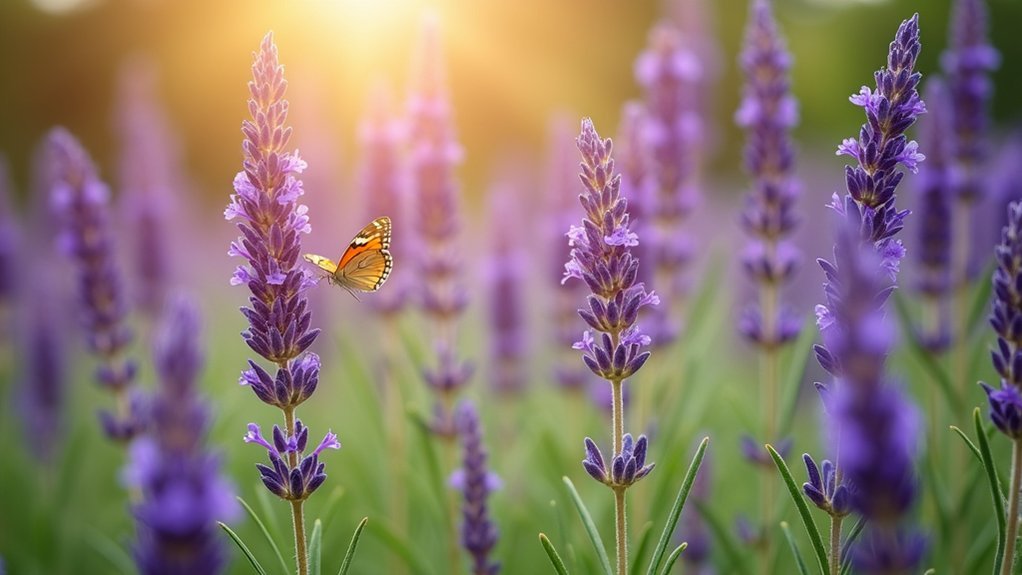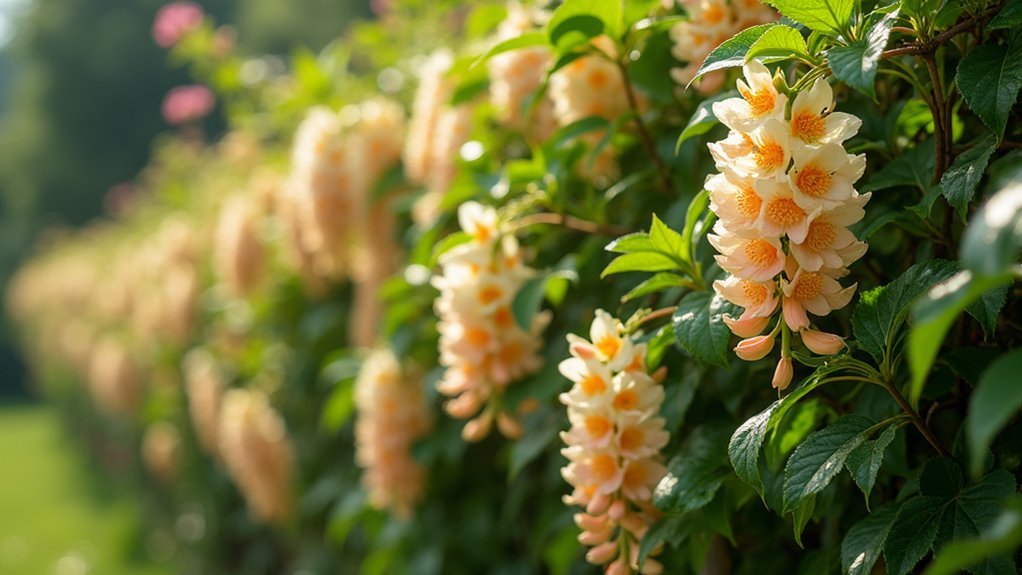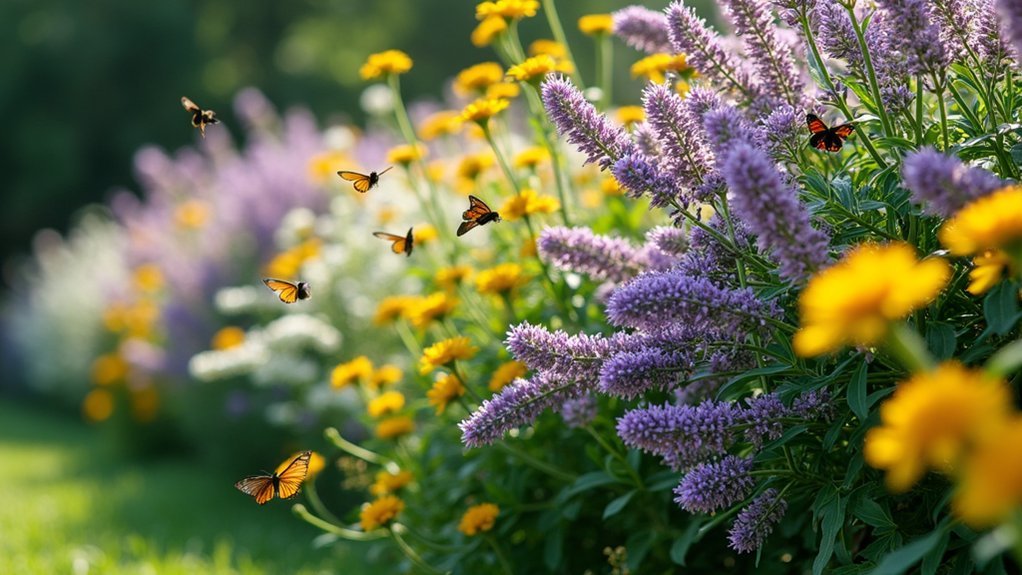Top fragrant plants for pollinator-friendly fence lines include lavender with its drought-tolerant purple blooms, climbing roses offering vertical beauty, and honeysuckle vines that attract hummingbirds. You’ll also find success with aromatic bee balm and native shrubs like abelia or winterberry. These plants transform ordinary boundaries into buzzing ecosystems while providing delightful scents throughout the growing season. Each plant offers unique benefits that enhance both your garden’s appearance and its ecological value.
Lavender: Nature’s Perfumed Pollinator Magnet

When planning a pollinator-friendly fence line, lavender stands out as one of the most rewarding choices you can make. This drought-tolerant perennial thrives in full sun and well-draining soil, creating a stunning display along boundaries in zones 5-11.
Lavender’s fragrant flowers aren’t just a treat for your senses—they’re crucial nectar-rich blooms that attract butterflies, honey bees, and other beneficial insects from late spring through early fall. You’ll enjoy improved garden aesthetics while supporting local biodiversity.
The aromatic leaves and purple blossoms serve multiple purposes beyond beautifying your landscape. You can harvest them for culinary uses, potpourri, or essential oils while still providing ample resources for pollinators.
Climbing Roses: Vertical Scents for Buzzing Visitors
Three distinct qualities make climbing roses exceptional additions to pollinator-friendly fence lines: their impressive vertical growth, intoxicating fragrance, and long blooming period.
Reaching heights of 15-30 feet, these vertical additions transform ordinary fences into pollinator havens.
You’ll need full sun and well-draining soil with a pH between 6.0-7.0 to optimize their potential.
The fragrant blooms act as powerful attractants for bees and butterflies, while simultaneously beautifying your garden spaces.
From late spring through fall, climbing roses serve as a continuous source of nectar and pollen for diverse pollinators.
To maintain their vigor, regularly prune and secure them to your fence with ties.
This maintenance guarantees these magnificent plants will reliably draw buzzing visitors to your garden all season long.
Honeysuckle: Sweet Nectar Vines for Fence Coverage

Native honeysuckle vines offer a threefold benefit for fence lines: abundant nectar, persistent blooms, and exceptional coverage. When you plant Lonicera sempervirens along your fence, you’re creating a pollinator paradise that thrives in full sun and adapts to various soil conditions.
This versatile vine grows 10-15 feet tall, transforming ordinary boundaries into lush, living walls.
- Produces tubular, fragrant flowers that specifically attract hummingbirds
- Blooms continuously from late spring through fall
- Creates dense coverage while requiring minimal maintenance
- Develops berries that provide food for birds, enhancing garden biodiversity
- Tolerates different soil types while maintaining its vigorous growth habit
The sweet nectar of honeysuckle doesn’t just perfume your garden—it sustains pollinators throughout the growing season, making your fence line an ecological hotspot.
Bee Balm: Aromatic Border Plants for Hummingbirds
Though often overlooked in fence plantings, Bee Balm (Monarda spp.) creates a hummingbird haven with its vibrant, aromatic blooms. This perennial powerhouse thrives in full sun across USDA zones 3-9, offering continuous nectar from late spring through fall.
| Bee Balm Benefits | For Your Garden | For Pollinators |
|---|---|---|
| Colorful Blooms | Red, purple, pink flowers | Attracts hummingbirds |
| Fragrant Foliage | Makes herbal tea | Draws beneficial insects |
| Long Blooming | Extended garden interest | Consistent nectar source |
You’ll appreciate how these aromatic plants serve double duty—beautifying your fence line while supporting pollinators. The tubular flowers are perfectly shaped for hummingbird feeding, while the fragrant foliage naturally deters garden pests. Plant bee balm in clusters along your fence for maximum impact and pollinator support.
Fragrant Native Shrubs: Year-Round Pollinator Support

When designing your fence line, fragrant native shrubs offer unparalleled value as year-round pollinator support systems. These low-maintenance options thrive in local conditions while providing essential nectar sources throughout multiple seasons.
You’ll enjoy the sensory experience of seasonal blooms while supporting vital biodiversity.
Varieties like Abelia, Coral Honeysuckle, Winterberry, and American Elderberry deliver both aromatic blooms and food sources for birds, ensuring continuous pollinator visitation.
- Select diverse shrubs for continuous bloom times from spring through fall
- Plant adaptable natives that require minimal care in your specific climate
- Position aromatic bloomers strategically to maximize both scent and visibility
- Incorporate berry-producing varieties to support birds year-round
- Layer different heights to create diverse pollinator habitats along your fence
Frequently Asked Questions
What Are the Fragrant Pollinator Plants?
You’ll find these fragrant pollinator plants in your garden: lavender, bee balm, catmint, borage, and anise hyssop. They’ll attract bees, butterflies, and hummingbirds while providing lovely scents throughout the growing season.
What Is the Best Low Maintenance Plant for a Fence Line?
For a low-maintenance fence line plant, you’ll love catmint (Nepeta). It thrives in zones 3-9 with minimal care once established, attracts pollinators, and creates a beautiful perimeter with virtually no effort from you.
Which Type of Plant Emits the Most Fragrance?
You’ll find that jasmine emits the most potent fragrance among common garden plants. Its intoxicating sweet scent can travel far, especially at night when it releases its strongest aromatic compounds to attract pollinators.
What Is the Most Fragrant Garden Plant?
Among your garden plant options, jasmine stands out as the most fragrant plant. It’s celebrated for its intense evening fragrance. You’ll notice its powerful scent even when you’re not directly beside the blooms.
In Summary
By planting these five fragrant options along your fence line, you’ll create a buzzing sanctuary that doubles as a beautiful, scented border for your yard. You’re not just enhancing your garden’s appeal—you’re providing essential habitats and food sources for struggling pollinator populations. Start with just one of these aromatic choices, and you’ll soon enjoy the sights and sounds of grateful winged visitors.





Leave a Reply